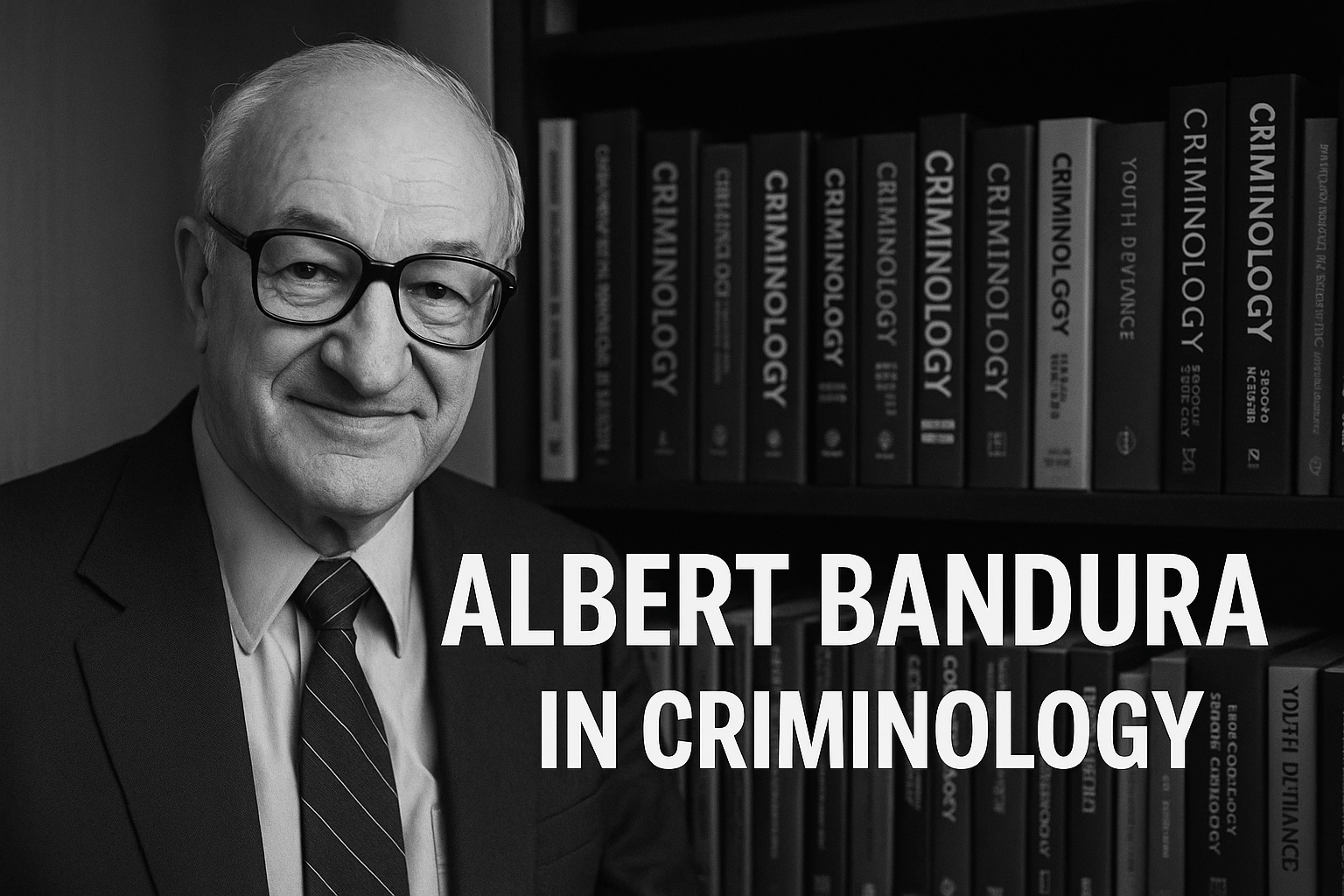Introduction: Rethinking Criminal Behavior through Social Learning
The study of crime has historically been shaped by competing paradigms—biological determinism, psychoanalytic drives, rational choice, and sociological theories of anomie and strain. Within this vast intellectual terrain, the work of Albert Bandura stands out for offering a framework that is both psychologically sound and socially grounded. Bandura’s Social Learning Theory (SLT) was revolutionary in shifting the lens of criminology toward the observational and cognitive processes that influence how individuals learn, imitate, and reinforce criminal behavior.
Bandura’s approach diverged sharply from earlier theorists such as Cesare Lombroso, who sought biological markers of criminality in physical traits, and Sigmund Freud, who viewed crime as an expression of unconscious conflict. Instead, Bandura proposed that behavior—criminal or otherwise—is learned in social contexts by observing models, retaining those observations, and reproducing the behaviors based on reinforcement expectations. This interpretation aligns more closely with modern behavioral science, where the interaction between the individual, their environment, and their cognitive interpretations of social cues shapes their conduct.
This theoretical foundation has significant implications. It allows criminologists to explain not only why people commit crimes but how deviant norms and behaviors spread across generations, neighborhoods, and institutions. The theory also aligns closely with more recent developments in neurocriminology, cognitive-behavioral interventions, and environmental criminology, which emphasize the brain’s plasticity and the adaptability of behavior through structured learning experiences.
Bandura’s contribution is especially relevant in a digital and globalized world where individuals are constantly exposed to models through media, social platforms, and online communities. In contrast to Sutherland’s Differential Association Theory, which focused on direct interaction, Bandura demonstrated that people could internalize behaviors from symbolic models, such as TV characters, YouTubers, or influencers, even in the absence of personal contact. This insight is critical to understanding phenomena such as cybercrime, online radicalization, and media violence.
This article will explore Bandura’s place within criminology by:
- Detailing his biographical context and academic development.
- Examining the mechanisms of Social Learning Theory in relation to criminal behavior.
- Comparing and contrasting his theory with that of other major criminological thinkers like Travis Hirschi, Howard Becker, and Edwin Sutherland.
- Applying his ideas to real-world scenarios involving youth violence, gang affiliation, domestic abuse, and institutional crime.
- Reviewing how his theory informs contemporary crime prevention and rehabilitation.
- Discussing critical evaluations and theoretical limitations of SLT.
Ultimately, this article aims to show that Bandura’s influence is not confined to psychology classrooms—it remains a living framework for understanding crime in modern society, offering a foundation for more empathetic, effective, and reform-oriented criminal justice strategies.
Who is Albert Bandura?
A Life of Inquiry and Innovation
Albert Bandura was born in 1925 in the small town of Mundare, Alberta, Canada, to parents of Eastern European descent. Despite humble beginnings, Bandura pursued a robust academic career, receiving his bachelor’s degree in psychology from the University of British Columbia in 1949, and later completing his Ph.D. at the University of Iowa in 1952—a university known for its rich tradition in experimental psychology.
Upon joining the faculty at Stanford University, Bandura began questioning the dominant psychological paradigms of the time. The behaviorism of Skinner, which posited that all learning occurred via conditioning and reinforcement, failed to explain complex human behaviors such as delayed gratification, empathy, or imitation without direct reward. Bandura’s curiosity led him to explore how people learn from others, especially in social situations where no explicit reinforcement is present.
The Bobo Doll Experiment and Observational Learning
In 1961, Bandura conducted his landmark Bobo Doll experiment, which forever changed the course of behavioral science. In this study, children observed adult models acting aggressively toward a large inflatable clown doll. Those who witnessed aggressive models were far more likely to imitate the violence—even without being rewarded for it—than those who observed non-aggressive or neutral models.
This experiment not only demonstrated the power of modeling but also refuted behaviorist ideas that direct reinforcement is necessary for learning. Bandura coined the term “observational learning” to describe this process and later integrated it into his broader Social Learning Theory, formalized in his 1977 book Social Learning Theory.
He later expanded his framework into Social Cognitive Theory, integrating concepts such as self-efficacy, reciprocal determinism, and symbolic modeling. In doing so, Bandura positioned himself at the intersection of cognition, behavior, and environment—a triadic model that explains how people both shape and are shaped by their surroundings.
From Psychology to Criminology
Although Bandura was trained as a psychologist, his ideas quickly found traction in criminology, sociology, and education. His assertion that behavior is learned within social contexts, and that individuals interpret and evaluate these contexts before acting, helped criminologists move beyond biological essentialism and punitive theories of crime. His work showed how crime could emerge in any population, regardless of genetics or class, if deviant behavior was modeled and rewarded.
Bandura’s influence extended to theories of moral disengagement, in which people justify harmful actions by reframing them morally, minimizing consequences, or dehumanizing victims. This concept is particularly useful in understanding organized crime, corporate malfeasance, and even war crimes—where perpetrators rationalize their actions through distorted moral reasoning.
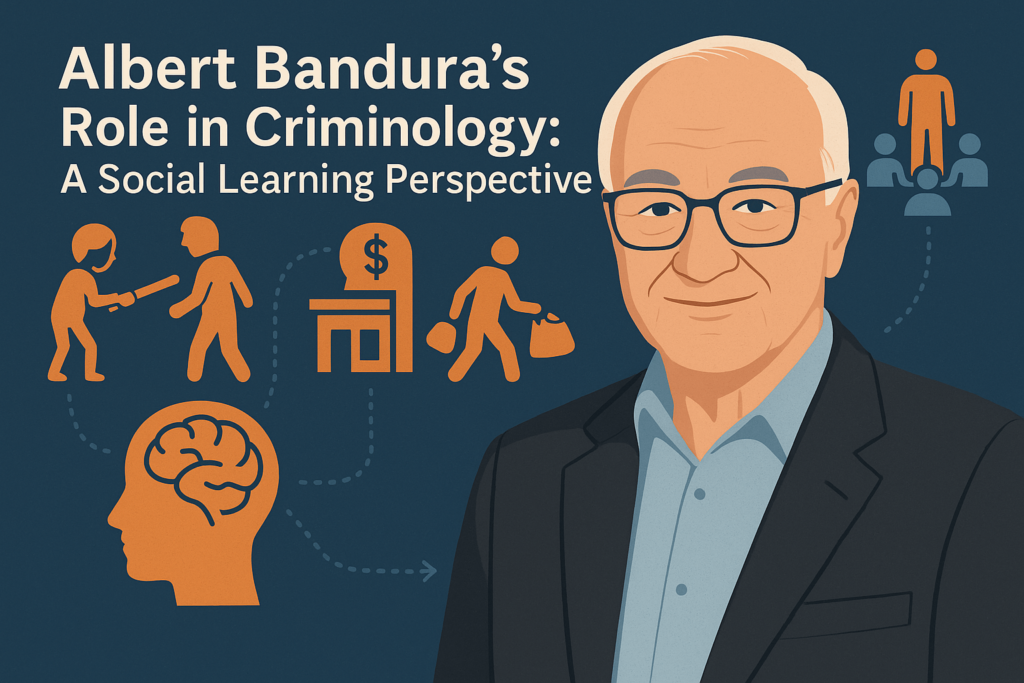
Social Learning Theory: The Foundation for Understanding Criminal Behavior
Core Mechanisms of Social Learning and Their Criminological Relevance
At the heart of Social Learning Theory (SLT) lies the belief that individuals learn new behaviors, values, and attitudes through the observation of others. Bandura’s model suggests that criminal behavior is not instinctual, nor always the product of rational choice, but is learned through exposure to influential social models—parents, peers, authority figures, and increasingly, media personalities.
SLT proposes a four-stage process through which individuals acquire new behaviors:
- Attention – An individual must notice and focus on the behavior of a model. Characteristics such as the model’s status, similarity, or charisma increase the likelihood of attention. In criminology, this helps explain why high-status gang leaders or dominant figures in criminal subcultures often influence younger or more impressionable individuals.
- Retention – The observed behavior must be mentally encoded and stored. This involves cognitive rehearsal and symbolic representation, allowing the observer to later recall and reproduce the behavior. A child who watches a sibling break into a car and escape arrest may later remember not only the act but the confidence and technique used.
- Reproduction – The individual must be capable of performing the behavior. This includes physical ability (e.g., strength, coordination) and psychological readiness (e.g., lack of guilt, confidence). Repeated exposure to deviant acts increases the likelihood of eventual imitation once opportunity aligns with perceived capability.
- Motivation – The observer must have a reason to act. This is where vicarious reinforcement becomes crucial: if the model is rewarded (social praise, money, power), the behavior is more likely to be repeated by the observer. If punished or humiliated, it becomes less attractive—though this can vary depending on the individual’s value system.
These four processes align well with the realities of crime. For example, youth living in disadvantaged communities may frequently observe violence being rewarded—either through material gains, peer approval, or survival. Conversely, prosocial behaviors such as academic success or lawful employment may receive no reinforcement or may even be ridiculed.
Symbolic Modeling and the Rise of Indirect Learning
Bandura extended SLT by introducing the concept of symbolic modeling—learning through fictional or mediated models. In today’s media-rich environment, individuals can learn behaviors from:
- Television shows depicting glorified violence or criminal lifestyles.
- YouTube and TikTok influencers engaging in risky or illegal acts.
- Online communities that normalize hate speech, extremism, or digital piracy.
These symbolic models may lack personal interaction, but they exert profound influence, especially when they are repeatedly consumed and framed positively. For instance, glorified depictions of drug dealers in popular music or cinema often portray such characters as powerful, respected, and emotionally detached—qualities that appeal to marginalized youth seeking agency and identity.
This symbolic learning process has been used to explain:
- The copycat effect, where individuals imitate crimes they see in the media.
- Online radicalization, where extremist ideologies are adopted through exposure to charismatic leaders or curated propaganda.
- The spread of cybercrime, where hackers demonstrate techniques that are quickly adopted by online communities.
Bandura argued that these influences are more powerful when there are no strong competing models or reinforcements for lawful behavior. In environments where parents are absent, schools are underfunded, and prosocial role models are scarce, symbolic modeling may become the primary source of behavioral learning.
Comparing Bandura with Other Criminological Thinkers
🔹 Edwin Sutherland: Differential Association Theory
Sutherland’s theory also posits that criminal behavior is learned, particularly in close peer groups. However, Sutherland focuses on direct communication—the transmission of definitions favorable to lawbreaking. Bandura, in contrast, broadens the scope: learning can occur without verbal instruction, through observation, mimicry, and interpretation of behavior. In other words, SLT complements and expands Differential Association Theory by emphasizing cognition and indirect exposure.
🔹 Travis Hirschi: Social Control Theory
Hirschi’s work answers a different question: not why people offend, but why most do not. He suggests that strong bonds to society (attachment, commitment, involvement, belief) prevent deviance. Bandura’s theory intersects here: where Hirschi’s bonds are weak or absent, deviant role models often fill the void. SLT shows what happens next—how these new models provide scripts for behavior.
🔹 Gabriel Tarde: Imitation Theory
French sociologist Gabriel Tarde was among the first to argue that criminal behavior is imitated. Bandura’s work built directly upon this idea but refined it through scientific experimentation and cognitive psychology. Unlike Tarde, who emphasized mass imitation, Bandura articulated why certain models are imitated and how the observer’s interpretation shapes imitation.
🔹 Howard Becker: Labeling Theory
Becker’s theory suggests that societal reaction and labeling contribute to continued deviance. Bandura’s model helps explain how labeled individuals may begin to internalize deviant models, particularly in institutional settings like prisons or reform schools. Exposure to hardened criminals becomes a modeling opportunity, especially when coupled with shame or social exclusion.
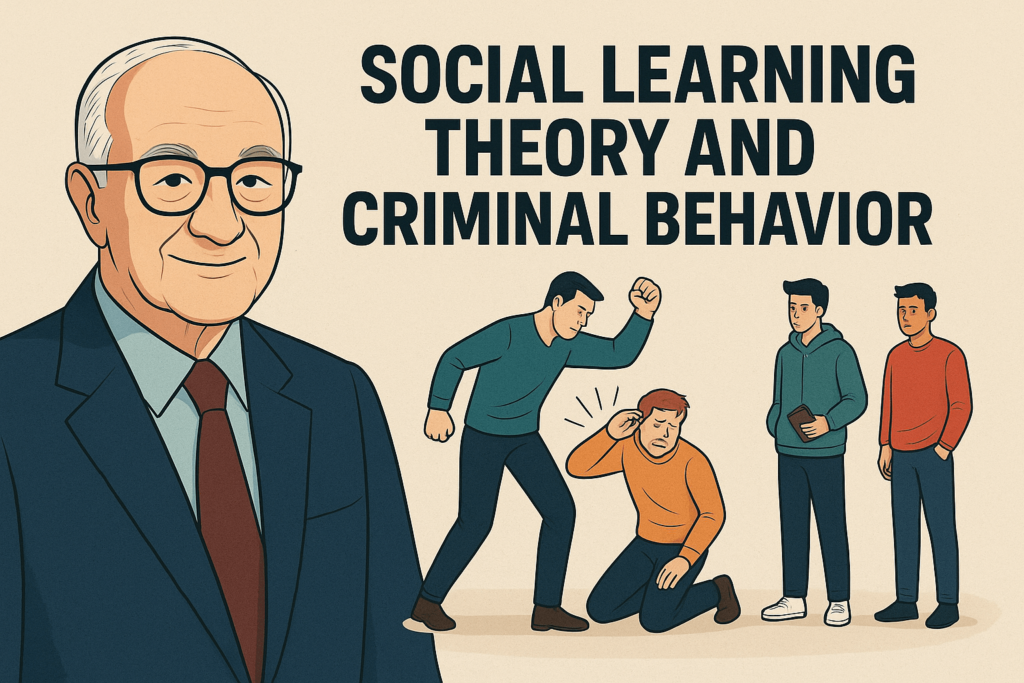
Applying Social Learning Theory to Crime
Learning Crime through Peer Groups, Family, and Social Context
Bandura’s Social Learning Theory explains criminal behavior as a product of social environments that reward deviance. These environments may be familial, peer-based, institutional, or even virtual. A central tenet of SLT is that when individuals are consistently exposed to criminal models, especially when those models are rewarded or admired, criminal behavior becomes more likely.
Let’s begin with peer influence, one of the most studied phenomena in juvenile criminology. Numerous studies have shown that adolescents who associate with delinquent peers are significantly more likely to commit crimes themselves. Bandura’s theory accounts for this not only as a matter of pressure but as observational learning. If a teenager sees friends engaging in vandalism and gaining group respect, they may begin to internalize that crime equals acceptance. The attention paid to these actions, their retention, and the social reward all align with Bandura’s four-stage model.
In the family context, SLT helps explain the intergenerational cycle of crime. Children growing up in homes where aggression, theft, substance abuse, or manipulation are normalized often witness these behaviors being modeled by trusted figures (e.g., parents, siblings). When these behaviors are not punished—or are even reinforced through material gain or social control—children may incorporate them into their own behavioral repertoire.
For example:
- A child sees their father intimidate neighbors and get what he wants.
- A teenager watches their mother shoplift and avoid consequences.
- A sibling boasts about cyberbullying with impunity on social media.
In each of these cases, observational learning may occur even if the child never engages directly in deviant acts during early years.
SLT also accounts for environmental reinforcement. In some communities, crime may be the only visible route to success. When youth observe that working honestly leads to poverty while drug dealing leads to wealth, the latter becomes a compelling model. In criminology, this aligns with the concept of “relative deprivation”, which explains how perceptions of inequality can create motivation to act outside the law—especially when criminal role models are already present.
Crime in Institutions and Workplaces: From Gangs to White-Collar Crime
While Bandura is often cited in juvenile delinquency research, his theory is equally relevant in understanding institutional crime, including gangs, prisons, and corporate environments.
Within gang culture, SLT explains how behaviors like violence, extortion, and drug trafficking are learned and perpetuated. Initiation rituals often involve watching or participating in violent acts under the supervision of older gang members. These acts are reinforced with symbols of status: tattoos, weapons, respect, and protection. Over time, the gang becomes the primary source of behavioral modeling, replacing parents or schools.
In prison environments, Social Learning Theory sheds light on how incarceration can become a “school for crime.” Inmates who were nonviolent offenders may enter a prison environment and observe hardened criminals manipulating systems, extorting others, or navigating hierarchies through dominance. With no countervailing prosocial models, and with violent or exploitative behavior rewarded through survival or status, these behaviors are easily imitated.
White-collar crime, though often less visible, fits neatly into Bandura’s framework. Consider a junior accountant who witnesses a senior executive falsifying records and receiving promotions or bonuses. Observing this behavior—and noting the lack of consequences—can reinforce the idea that unethical behavior is tolerated or even necessary for advancement.
This reveals a key strength of Bandura’s theory: it accounts for crime across social classes, from street violence to embezzlement, from gang initiation to tax evasion. The critical constant is the presence of modeled behavior that is observed, remembered, reproduced, and rewarded.
Digital Modeling and Modern Criminal Learning
In today’s digital age, Bandura’s insights are more relevant than ever. Observational learning now takes place on social media platforms, YouTube, TikTok, and encrypted forums. Digital influencers can function as models for:
- Online scams: Videos teaching others how to exploit vulnerabilities in apps.
- Hacktivism and cyberattacks: Tutorials that romanticize digital rebellion.
- Radicalization: Content that glorifies extremist ideology.
Bandura warned early on about the dangers of symbolic modeling—learning from characters, avatars, or digital content. This form of modeling is particularly powerful when:
- The model is charismatic or high-status.
- The behavior is associated with empowerment or prestige.
- There is no direct contact with the legal or moral consequences of the act.
This aspect of SLT helps explain the rise in cybercrime, online harassment, and youth involvement in digital subcultures. Individuals no longer need to be part of a physical gang or group—they can now observe, internalize, and reproduce deviant behavior entirely in the virtual realm.
Bandura’s Role in Crime Prevention and Rehabilitation
Prevention through Early Intervention and Pro-Social Modeling
Social Learning Theory has played a vital role in shaping evidence-based prevention programs, especially those targeting children and adolescents. Prevention efforts grounded in SLT aim to:
- Provide positive models in schools, communities, and families.
- Reinforce prosocial behavior through rewards, praise, and recognition.
- Disrupt deviant modeling environments and limit exposure to harmful models.
Programs like life-skills training, social-emotional learning, and peer mentoring are built on Bandura’s principles. They seek to saturate the child’s environment with pro-social cues—role models who handle conflict peacefully, pursue education, and show empathy.
One powerful example is the “Big Brothers Big Sisters” mentoring initiative, which pairs youth with adult mentors who serve as consistent, law-abiding role models. Research has shown reductions in arrests and antisocial behavior among participants—evidence of SLT in practice.
Schools can also apply SLT by incorporating modeling and reinforcement into their behavior management strategies:
- Teachers model calm problem-solving and nonviolence.
- Peer leaders model respect and cooperation.
- Behavioral rewards promote repetition of desirable conduct.
Rehabilitation through Cognitive-Behavioral Strategies
In correctional settings, Cognitive Behavioral Therapy (CBT) often relies on Bandura’s insights. CBT programs for offenders focus on:
- Identifying learned patterns of thought and behavior.
- Replacing them with alternative responses modeled by therapists or group members.
- Practicing new behaviors in simulated situations.
- Receiving reinforcement through support, feedback, and internal satisfaction.
One widely studied example is Aggression Replacement Training (ART), used with violent offenders. Participants observe modeled non-aggressive responses to provocation, role-play those responses, and receive feedback from peers and counselors.
Another intervention inspired by Bandura’s theory is Moral Reconation Therapy (MRT). This program challenges offenders’ cognitive distortions and introduces moral reasoning through narratives and examples—replacing immoral models with ethical ones.
In reentry programs, mentorship again plays a central role. Ex-offenders are paired with successful reintegrated individuals who model employment, sobriety, and healthy relationships. Observing these models builds self-efficacy, a Bandura concept referring to belief in one’s ability to succeed. Research shows that higher self-efficacy correlates with lower recidivism.
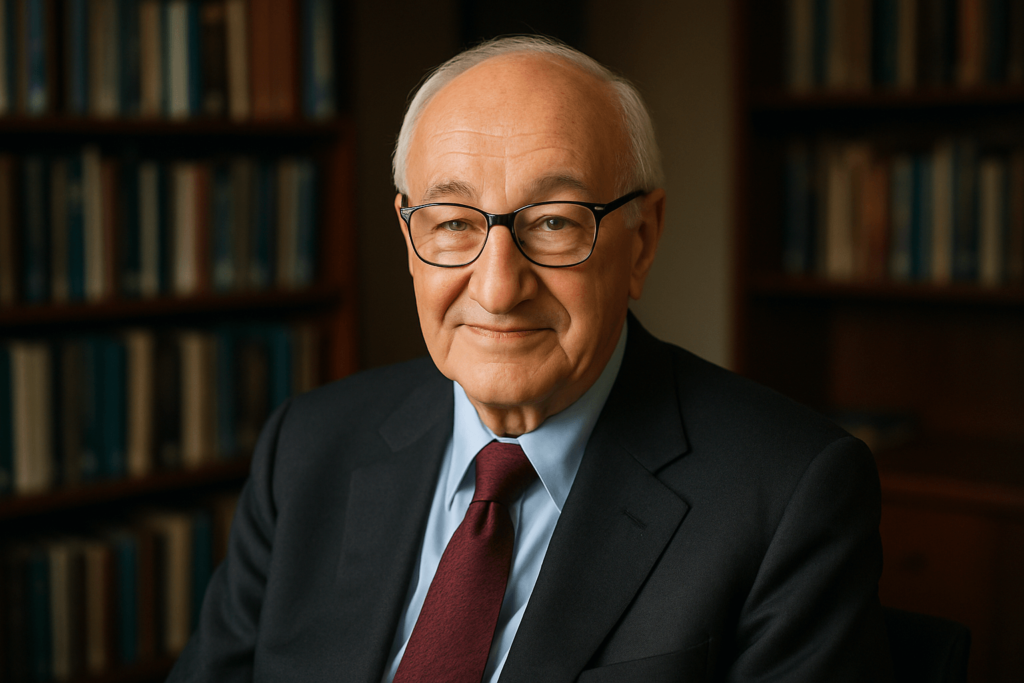
Critiques and Limitations of Bandura’s Theory in Criminology
Biological, Neurological, and Genetic Oversights
One of the most persistent criticisms of Bandura’s Social Learning Theory, especially when applied to criminology, is its limited integration of biological and neurological factors in explaining behavior. While Bandura does acknowledge the influence of personal and cognitive factors, his model is primarily focused on external social dynamics and environmental modeling. In contrast, emerging fields such as neurocriminology argue that structural and chemical abnormalities in the brain—such as reduced activity in the prefrontal cortex or high levels of testosterone—can significantly contribute to aggression and impulsivity.
Pioneers in this area, like Adrian Raine, suggest that individuals with certain genetic predispositions or neurological deficits may be less responsive to social cues and reinforcement. For instance, an individual with impaired impulse control due to frontal lobe dysfunction may not be capable of the cognitive reflection necessary for Bandura’s four-step learning process. This calls into question whether SLT can adequately explain chronic violent offenders or individuals with severe antisocial personality disorder.
Furthermore, twin and adoption studies—including those by scholars like Sarnoff Mednick—show strong correlations between inherited traits and criminal behavior. These findings suggest that while social learning plays a role, it must be integrated with biosocial models to offer a more holistic understanding of criminality.
Variability in Model Imitation and the Role of Free Will
Another major critique of SLT is its limited explanation for individual variability in behavior imitation. Why do some people exposed to violent or deviant models become offenders, while others do not? Bandura would argue that factors such as attention, self-efficacy, and reinforcement expectations explain this discrepancy. However, critics argue that this explanation is circular and lacks predictive power.
Consider two youths exposed to the same violent environment: one becomes involved in crime; the other does not. SLT can explain the process retrospectively but does not offer robust criteria to predict outcomes ahead of time. Furthermore, it underplays personal agency, moral reasoning, and free will—all of which play crucial roles in whether or not an individual chooses to act on learned behavior.
The philosopher Jean-Paul Sartre, though outside criminology, emphasized the existential notion that individuals are free to choose their path, regardless of circumstance. While SLT recognizes personal reflection, it does not fully capture the moral deliberation and conscious resistance some individuals demonstrate, even when surrounded by deviance.
Structural, Economic, and Cultural Blind Spots
Perhaps the most significant limitation of Bandura’s theory from a criminological standpoint is its micro-level focus. SLT largely ignores macro-structural factors such as poverty, systemic racism, economic inequality, and institutional corruption. These are the domains explored by conflict theorists like Richard Quinney, William Chambliss, and Karl Marx, who argue that crime is often a rational response to structural injustice rather than poor modeling.
For example:
- A young person who joins a gang may be less influenced by observed deviance and more motivated by the absence of opportunity.
- A corporate executive engaging in insider trading may be reacting to capitalist pressure to maximize profits, not merely copying a deviant mentor.
While SLT helps explain the mechanisms by which individuals learn behavior, it may misrepresent the root causes. Crime is not merely a matter of bad role models—it often emerges from social systems that produce, concentrate, and reward deviance in specific populations.
This critique does not invalidate SLT but highlights the need to integrate it within broader theoretical frameworks that include economic, political, and historical contexts.
Conclusion: Bandura’s Enduring Legacy in Criminological Thought
Albert Bandura’s influence on criminology represents a paradigm shift away from rigid biological and deterministic explanations of crime. His Social Learning Theory provides a nuanced, accessible, and empirically supported framework for understanding how individuals observe, internalize, and reproduce deviant behavior in a social context. It reveals that crime is not an isolated decision or an inherited flaw but often the result of learned behavior shaped by family, peers, institutions, and media.
Bandura’s model has become the backbone of numerous preventive and rehabilitative programs. From youth mentoring initiatives to offender reentry programs, from classroom management strategies to prison-based CBT, his ideas have shaped real-world policy and intervention on a global scale. His emphasis on modeling, reinforcement, and self-efficacy has also aligned with modern movements in restorative justice, trauma-informed care, and behavior modification.
At the same time, Bandura’s theory is not without its limitations. It must be critically applied and integrated with complementary theories, especially those that examine the biological, structural, and cultural dimensions of crime. No single theory can fully explain the complexity of human deviance, but Bandura’s contribution provides a powerful lens for both understanding and changing criminal behavior.
As we move further into a digital, media-saturated age, Bandura’s emphasis on symbolic modeling and indirect learning becomes even more essential. Youth today are influenced not only by family and community but also by influencers, streamers, and algorithms. In this landscape, understanding how behavior is observed and learned is more critical than ever.
Bandura once said, “People are producers of their environment as well as products of it.” This insight remains at the heart of criminological reform: change is not only possible—it is learnable
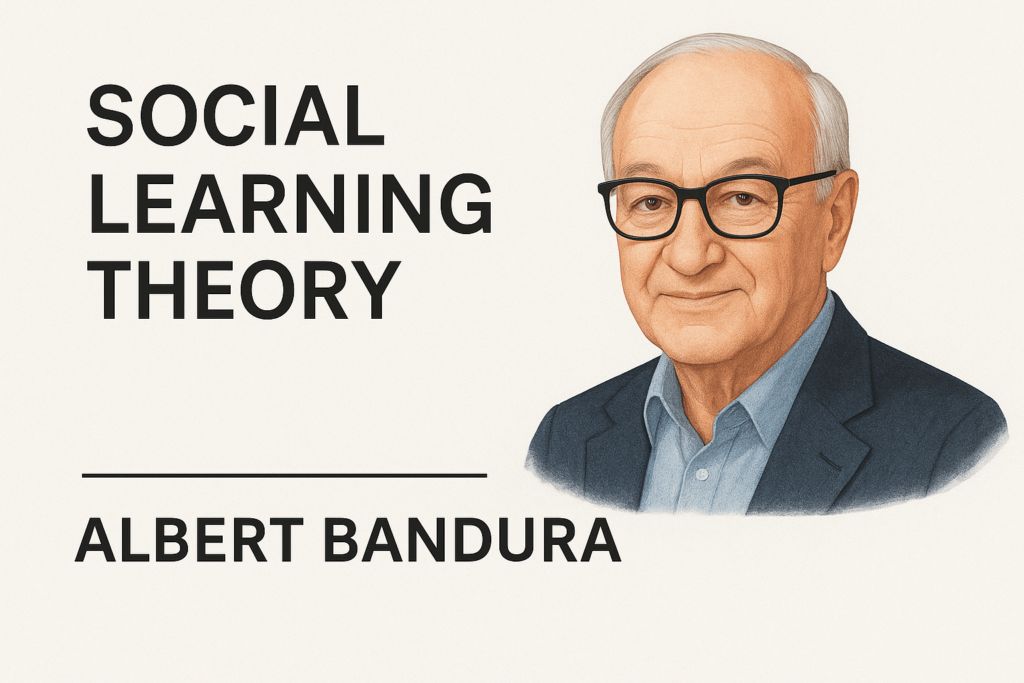
References
- Bandura, A. (1977). Social Learning Theory. Englewood Cliffs, NJ: Prentice-Hall.
- Shelton, S. (2021). The Application of Social Learning Theory to the Correctional Setting by Case Examples. International Association for Correctional & Forensic Psychology (IACFP). Retrieved from:
https://www.myiacfp.org/the-application-of-social-learning-theory-to-the-correctional-setting-by-case-examples/ - Sharma, K., & Gupta, K. (2024). An Exploration of Social Learning Theory in Understanding the Shifting Dynamics of Juvenile Crime. Journal of Innovation in Educational Research. Retrieved from:
https://jier.org/index.php/journal/article/view/1547 - American International Journal of Contemporary Research (2021). A Comprehensive Analysis of Social Learning Theory Linked to Criminology. Volume 11, Issue 2. Retrieved from:
https://www.aijcrnet.com/journals/Vol_11_No_2_June_2021/2.pdf - SAGE Knowledge. Bandura, Albert: Social Learning Theory. In Encyclopedia of Criminological Theory. Retrieved from:
https://sk.sagepub.com/ency/criminologicaltheory/n25.xml - Costello, B. J., & Laub, J. H. (2020). Social Control Theory: The Legacy of Travis Hirschi’s Causes of Delinquency. Annual Review of Criminology, 3, 21–41. Review of Hirschi’s influential work on social bonds annualreviews.org+2annualreviews.org+2.
- L. T. Winfree, T. Vigil Bäckström, & G. L. Mays (1994). Social Learning Theory, Self-Reported Delinquency, and Youth Gangs: A New Twist on a General Theory of Crime and Delinquency. Journal of Youth and Society journals.sagepub.com.
- Krohn, M. D. (1999). Social Learning Theory. Theoretical Criminology, 3(4). A theoretical update on SLT’s influence in criminology journals.sagepub.com.
- Kaya, F., & Buzlu, S. (2016). Effects of Aggression Replacement Training on Problem-Solving, Anger and Aggressive Behaviour among Adolescents with Criminal Attempts in Turkey. Archives of Psychiatric Nursing link.springer.com.
- Boman, J. H. IV, Mowen, T. J., & Higgins, G. E. (2018). Social Learning, Self-Control, and Offending Specialization and Versatility among Friends. American Journal of Criminal Justice, 44(1), 3–22 pmc.ncbi.nlm.nih.gov.
- Clarke, D. V. (2023). Social Learning Theory: How Behavior Is Shaped by Social Interactions and Observational Learning. Addiction & Criminology, 6(3):150 numberanalytics.com+4Allied Academies+4Reddit+4.
- Akers, R. L., & Jensen, G. F. (2003, 2006, 2008). Seminal volumes in Social Learning Theory and the Explanation of Crime and Criminological Theories—detailed theoretical frameworks and empirical reviews Allied Academies+4oxfordbibliographies.com+4ResearchGate+4.
- Winfree, L. T. Jr., Mays, G. L., Fuller, K., & Jackson, S. (1993–1994). Various studies on youth gangs contextualized by SLT journals.sagepub.com.
- Wikström, P.-O. H. (2006–2022). Situational Action Theory and the Peterborough Adolescent and Young Adult Study (PADS+), integrating environment and moral cognition into crime causation

